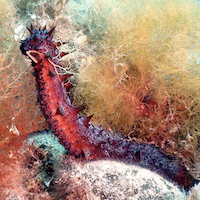Trace metal levels in the edible tissues of sea cucumbers (Holothuria tubulosa and Holothuria polii) from Sardinia (Western Mediterranean)

Submitted: 29 December 2020
Accepted: 6 July 2021
Published: 29 September 2021
Accepted: 6 July 2021
Abstract Views: 804
PDF: 337
HTML: 7
HTML: 7
Publisher's note
All claims expressed in this article are solely those of the authors and do not necessarily represent those of their affiliated organizations, or those of the publisher, the editors and the reviewers. Any product that may be evaluated in this article or claim that may be made by its manufacturer is not guaranteed or endorsed by the publisher.
All claims expressed in this article are solely those of the authors and do not necessarily represent those of their affiliated organizations, or those of the publisher, the editors and the reviewers. Any product that may be evaluated in this article or claim that may be made by its manufacturer is not guaranteed or endorsed by the publisher.

 https://doi.org/10.4081/ijfs.2021.9576
https://doi.org/10.4081/ijfs.2021.9576



